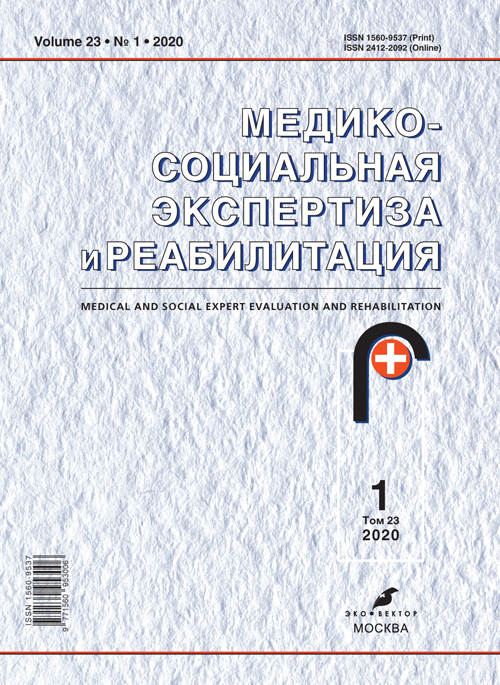Neural network analysis of heart rhythm variability for diagnosis of immobilization syndrome and objectivization of effectiveness of early rehabilitation
- Authors: Nekrasova J.Y.1,2, Yankevich D.S.1, Kanarsky М.М.1, Markov A.S.2
-
Affiliations:
- Federal Research and Clinical Center of Intensive Care and Rehabilitology
- Moscow Aviation Institute (National Research University)
- Issue: Vol 23, No 1 (2020)
- Pages: 9-17
- Section: Articles
- URL: https://rjmseer.com/1560-9537/article/view/34233
- DOI: https://doi.org/10.17816/MSER34233
- ID: 34233
Cite item
Abstract
The article discusses the use of a neural network analysis of heart rate variability for the diagnosis of immobilization syndrome and post-intensive care syndrome (PICS) in patients with disorders of consciousness for monitoring the quality of the rehabilitation process. It is shown that there are statistical differences between the curves characterizing the heart rate variability of healthy patients and patients with impaired consciousness. The use of a neural network allows to automatically evaluate the severity of the immobilization syndrome and Post Intensive Care Syndrome, as well as the effectiveness of measures for their prevention and the overall quality of the work of medical personnel.
Full Text
About the authors
Julia Yu. Nekrasova
Federal Research and Clinical Center of Intensive Care and Rehabilitology; Moscow Aviation Institute (National Research University)
Author for correspondence.
Email: nekrasova84@yandex.ru
ORCID iD: 0000-0002-4435-8501
SPIN-code: 8947-4230
Russian Federation, Moscow
D. S. Yankevich
Federal Research and Clinical Center of Intensive Care and Rehabilitology
Email: yanson_d@mail.ru
ORCID iD: 0000-0001-5143-7366
SPIN-code: 6506-8058
к.м.н.
Russian Federation, MoscowМ. М. Kanarsky
Federal Research and Clinical Center of Intensive Care and Rehabilitology
Email: kanarMM@yandex.ru
ORCID iD: 0000-0002-7635-1048
SPIN-code: 1776-1160
Russian Federation, Moscow
A. S. Markov
Moscow Aviation Institute (National Research University)
Email: arxitektor33@yandex.ru
студент
Russian Federation, MoscowReferences
- Siman-Tov M, Radomislensky I, Peleg K. Reduction in trauma mortality in Israel during the last decade (2000–2010): The impact of changes in the trauma system. Injury. 2013;44(11):1448–1452. https://doi.org/10.1016/j.injury.2012.08.054.
- Wang X, Sun X, Liu H. Clinical analysis and misdiagnosis of cerebral venous thrombosis. Exp Ther Med. 2012;4(5):923–927. https://doi.org/10.3892/etm.2012.697.
- Levin HS, Saydjari C, Eisenberg HM, et al. Vegetative state after closed-head injury. A traumatic coma data bank report. Arch Neurol. 1991;48(6):580–585. https://doi.org/10.1001/archneur.1991.00530180032013.
- Vertikalizatsiya patsiyentov v protsesse reabilitatsii. Klinicheskiye rekomendatsii. Moscow; 2014. 63 р. (In Russ).
- Belkin AA, Alasheev AM, Davyidova NS, et al. Obosnovanie reanimatsionnoy reabilitatsii v profilaktike i lechenii sindroma “posle intensivnoy terapii” (PIT-sindrom). Vestnik vosstanovitelnoy meditsinyi. 2014;(1):37–43. (In Russ).
- Chakko S, Mulingtapang RF, Huikuri HV, et al. Alterations in heart rate variability and its circadian rhythm in hypertensive patients with left ventricular hypertrophy free of coronary artery disease. Am Heart J. 1993;126(6):1364−1372. https://doi.org/10.1016/0002-8703(93)90535-h.
- Kleiger RE, Miller P, Bigger JT, et al. Decreased heart rate variability and its association with increased mortality after acute myocardial infarction. Am J Cardiol. 1987;59(4):256−262. https://doi.org/10.1016/0002-9149(87)90795-8.
- Malpas SC, Maling TJ. Heart-rate variability and cardiac autonomic function in diabetes. Diabetes. 1990;39(10):1177−1181. https://doi.org/10.2337/diab.39.10.1177.
- Kiselev AR, Shvartz VA, Karavaev AS, et al. Correlations between cardiovascular autonomic control indices during the two-hour immobilization test in healthy subjects. Open Cardiovasc Med J. 2016;10:35−43. https://doi.org/10.2174/1874192401610010035.
- Swai J, Hu Z, Zhao X, et al. Heart rate and heart rate variability comparison between postural orthostatic tachycardia syndrome versus healthy participants; a systematic review and meta-analysis. BMC Cardiovasc Disord. 2019;19(1):320. https://doi.org/10.1186/s12872-019-01298-y.
- Plaza-Florido A, Migueles JH, Sacha J, Ortega FB. The role of heart rate in the assessment of cardiac autonomic modulation with heart rate variability. Clin Res Cardiol. 2019;108(12):1408–1409. https://doi.org/10.1007/s00392-019-01486-y.
- Ahmad S, Tejuja A, Newman KD, et al. Clinical review: a review and analysis of heart rate variability and the diagnosis and prognosis of infection. Crit Care. 2009;13(6):232. https://doi.org/10.1186/cc8132.
- Johnston BW, Barrett-Jolley R, Krige A, Welters ID. Heart rate variability: Measurement and emerging use in critical care medicine. J Intensive Care Soc. 2020;21(2):148−157. https://doi.org/10.1177/1751143719853744.
- Baevsky RM, Goncharova AG, Funtova II, Chernikova AG. Change of heart rate variability and blood pressure in the experiment with 120-daily hypokinesia. In: Hypokinesia. Medical and psychological problems. Moscow: GNTs RF IMBP; 1997. Р. 9–10.
- Mazzeo AT, La Monaca E, Di Leo R, et al. Heart rate variability: a diagnostic and prognostic tool in anesthesia and intensive care. Acta Anaesthesiol Scand. 2011;55(7):797–811. https://doi.org/10.1111/j.1399-6576.2011.02466. x.
- Karmali SN, Sciusco A, May SM, Ackland GL. Heart rate variability in critical care medicine: a systematic review. Intensive Care Med Exp. 2017;5(1):33. https://doi.org/10.1186/s40635-017-0146-1.
- Marsillio LE, Manghi T, Carroll MS, et al. Heart rate variability as a marker of recovery from critical illness in children. PLoS One. 2019;14(5):e0215930. https://doi.org/10.1371/journal.pone.0215930.
- MIT-BIH Normal Sinus Rhythm Database v1.0.0. [accessed on 28 December 2019] Available from: https://physionet.org/content/nsrdb/1.0.0/.
- Dorogovtsev VN, Skvortsov AE, Yudina EA. Changes in systemic hemodynamics in orthostasis in patients with long-term impairment of consciousness. General Reanimatology. 2018;14(6):12−22. (In Russ). https://doi.org/10.15360/1813-9779-2018-6-12-22.
- Dorogovtsev VN, Yankevich DS, Melnikov OA. Orthostatic circulatory disturbances during verticalization in post-comatose patients after severe brain damage. Physical and rehabilitation medicine, medical rehabilitation. 2020;2(2):9–21. https://doi.org/10.36425/rehab25748.
Supplementary files















